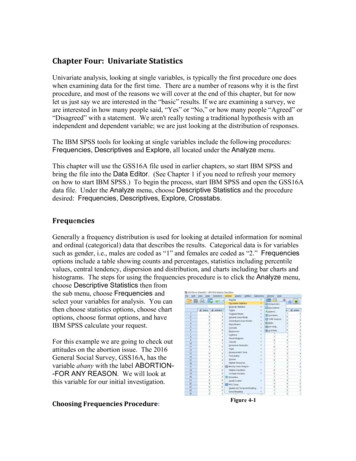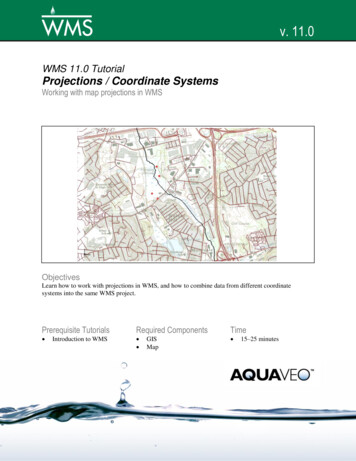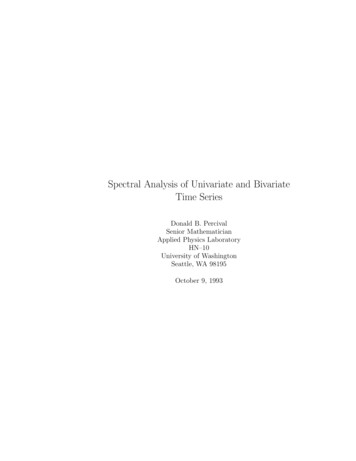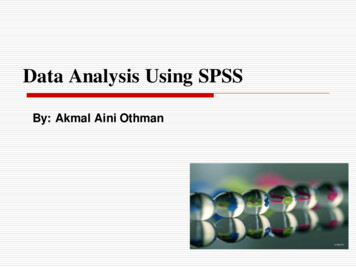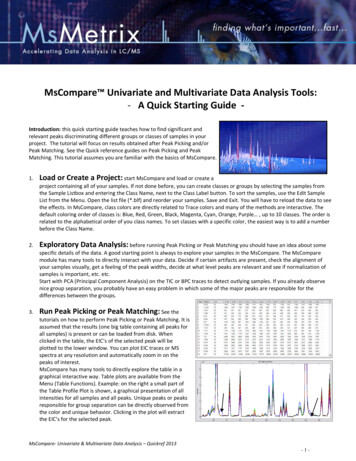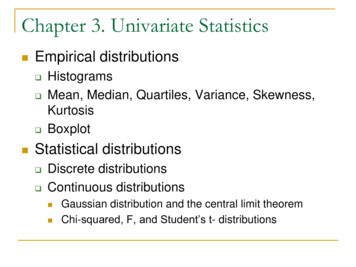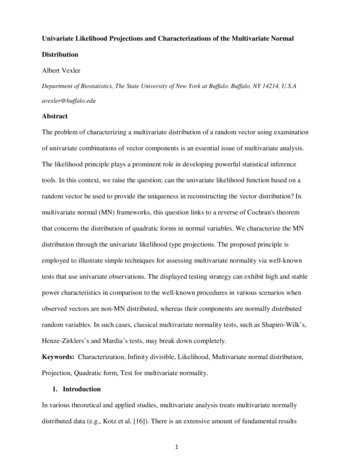
Transcription
Univariate Likelihood Projections and Characterizations of the Multivariate NormalDistributionAlbert VexlerDepartment of Biostatistics, The State University of New York at Buffalo, Buffalo, NY 14214, U.S.Aavexler@buffalo.eduAbstractThe problem of characterizing a multivariate distribution of a random vector using examinationof univariate combinations of vector components is an essential issue of multivariate analysis.The likelihood principle plays a prominent role in developing powerful statistical inferencetools. In this context, we raise the question: can the univariate likelihood function based on arandom vector be used to provide the uniqueness in reconstructing the vector distribution? Inmultivariate normal (MN) frameworks, this question links to a reverse of Cochran's theoremthat concerns the distribution of quadratic forms in normal variables. We characterize the MNdistribution through the univariate likelihood type projections. The proposed principle isemployed to illustrate simple techniques for assessing multivariate normality via well-knowntests that use univariate observations. The displayed testing strategy can exhibit high and stablepower characteristics in comparison to the well-known procedures in various scenarios whenobserved vectors are non-MN distributed, whereas their components are normally distributedrandom variables. In such cases, classical multivariate normality tests, such as Shapiro-Wilk’s,Henze-Zirklers’s and Mardia’s tests, may break down completely.Keywords: Characterization, Infinity divisible, Likelihood, Multivariate normal distribution,Projection, Quadratic form, Test for multivariate normality.1. IntroductionIn various theoretical and applied studies, multivariate analysis treats multivariate normallydistributed data (e.g., Kotz et al. [16]). There is an extensive amount of fundamental results1
related to characterizations of the multivariate normal distribution. In this context,characterizations of multivariate normality (MN) through univariate projections playfundamental roles, providing relatively simple procedures to assess the assumption of MNregarding a random vector distribution (e.g., Shao and Zhou [30]; Cuesta-Albertos et al. [8];Looney [20]). Univariate characterizations of MN play an important part in differentapplications to multivariate data based comparisons, simulations and stochastic modeling (e.g.,Nagaraja [22]). Perhaps, mostly addressed univariate characterization of MN employs that therandom variables X 1 , , X p are jointly normal if and only if every linear combination of themis a univariate normal. This property underlies many strategies of multivariate comparisons,stochastic modeling and testing for MN that have structures of powerful techniques developedin the univariate cases (e.g., Looney [20]; Zhu et al. [37]).An important critical result is that the MN of all subsets (r p ) of the normal variablesX 1 , , X p together with the normality of an infinity number of linear combinations of them donot insure the joint normality of these variables, when p 2 (e.g., Hamedani [10]). This raisesa vital concern regarding the common statistical procedures, e.g., for assessing MN of a randomvector by examining a limited number of linear combinations of its components (e.g., Shao andZhou [30]). In practice, technical reasons restrict the number of the linear combinations to beconsidered.The main aim of this paper is to introduce an alternative univariate projection of MN that isinspired by the following statements. The likelihood principle plays a prominent role indeveloping powerful statistical inference tools (e.g., Vexler and Hutson [35]). Oftentimes,likelihood functions assist to derive sufficient information regarding observed data. Then, onemight ask: can a distribution of the likelihood function based on the vector X ( X 1 , , X p )Tbe involved in complete reconstruction of X ’s distribution? (In this context, the term2
“likelihood function” is defined as the joint density function of X , say f , computed in theform f ( X 1 , , X p ) .) The likelihood function based on X is a univariate random variable.In the case where X is MN distributed, the corresponding log likelihood function can bedirectly associated with so called quadratic forms (see Section 2 for details). According toRuben [28], “from a substantive or statistical point of view the characterization of normality viaquadratic forms must rank as of greater interest when one bears in mind that the core ofstatistical science, namely the entire vast area of regression analysis, including analysis ofvariance, is based on quadratic forms of the components of the observation vector.” Ruben [28]provided characterizations of normality, showing that, when X 1 , , X p are symmetric,independently and identically distributed random variables with zero means and finitevariances, the corresponding quadratic form has a chi-squared distribution if and only if X 1 isnormal. This approach can characterize X 1 , , X p as normally distributed random variables,but does not sufficiently imply that X is MN -distributed (Hamedani [10]). Indeed, it is oftheoretical and applied interest to release the conditions regarding independence of X ’scomponents and their symmetry.In Section 2, we establish a new characterization of MN for a random vector by examiningthe relevant quadratic form. The obtained results can underlie a reverse of Cochran's theorem(e.g., Styan [32]) that concerns the distribution of quadratic forms in normal variables. It turnsout that, in general cases, we can provide one-to-one mapping between the likelihood’s andX ’s distributions, using properties of infinity divisible (ID) distribution functions. For anextensive review and examples related to univariate and multivariate ID distributions, we referthe reader to Bose et al. [4]. We point out that the problem of univariate likelihood projectionscan be linked to the issue of reconstructing summands distributions by a distribution of theirsum. In this context, the conclusions of Prokhorov and Ushakov [24] (see Theorem 1 and its3
Corollary in [23]) show that, even in the simple case of independent X 1 , , X p , the IDassumption applied in Section 2 cannot be significantly improved.In Section 3, we exemplify an application of the proposed method, constructing simple testsfor MN. Although many techniques for assessing MN have been proposed (e.g., Kim and Park[15]), there is still a paucity of genuine statistical tests for MN (e.g., Kotz et al. [16]). Takinginto account the arguments presented by Looney [20], we demonstrate techniques for assessingMN based on well-known tests that use univariate observations. We experimentally show thatthe presented likelihood projection based testing strategy can exhibit high and stable powercharacteristics in comparison to the relevant well-known classical procedures in variousscenarios when X is not MN-distributed, whereas X 1 , , X p are dependent or independentnormally distributed random variables (Stoyanov [31]). In such cases, the Shapiro-Wilk, HenzeZirklers and the Mardia multivariate normality tests may break down completely. In Section 4the proposed method is applied to a biomarker study associated with myocardial infarctiondisease. We conclude with remarks in Section 5.2. Likelihood projectionsWe first introduce the basic notation regarding the statement of the problem. Then the mainresults are provided in Theorems 1 and 2 that establish univariate likelihood basedcharacterizations of MN. The proofs of Theorems 1 and 2 are included for completeness andcontain comments that assist to describe the obtained results. Important notes related toconditions used in the proposed technique are presented in Remarks.Let X ( X 1 , , X p ) be the p-dimensional random vector with mean vectorTµ ( µ1 , , µ p ) and covariance matrix Σ . The covariance matrix Σ is positive-definite. ThenTwe can use an orthogonal (orthonormal) matrix Q to present the diagonalizable form of Σ ,4
the matrix Λ diag ( λ λi 0, i 1,., p, (e.g., Baldessari [1]).Q T ΣQ Λ , where1 , , λ p ) ,Define the following matrices diag ( λ1 1/2 , , λ p 1/2 ) , H QT Q, and z H ( X µ ) .Obviously H is symmetric (e.g., H H T ) and H T H QT QQT Q QT Λ 1Q QT Σ 1Q ,since the equation QT ΣQ Λ provides Σ QΛQT after applying the inverse of both sides andusing that the inverse of an orthogonal matrix is equal to its transpose. Also we haveH ΣH T Q QT ΣQ QT Q QT QΛQT Q QT I p ,where I p is the identity matrix of size p .Assuming that X is observed and follows a multivariate normal distribution, sayX N p ( µ , Σ ) , we can write the conventional likelihood functionL( 2π ) p /2A1/2exp { 0.5W } , where A Σ 1 is a real symmetric positively defined matrixand the quadratic form W ( X µ ) A ( X µ ) . It is clear that the distribution of WTdetermines the distribution of L and vice versa. Note thatW ( X µ ) Σ 1 ( X µ ) ( X µ ) H T H ( X µ ) H ( X µ ) H ( X µ ) z T z ,TTTwhere z H (X µ).Theorem 1 (Likelihood Projection and Characterization). The following two statements areequivalent:(a) X is an infinitely divisible random (ID) vector (e.g., Bose et al. [4]), the random vectorz consists of p independent components and the random variable z T z W has the chi-square distribution with p degrees of freedom, say z T z χ p2 .(b) X N p ( µ , Σ ) .5
Proof. Under Statement (a), we have z H ( X µ ) ( z1 ,., z p )T , where zi is a linearcombination of X 1 , , X p , i 1,., p . Therefore, for all i {1,., p} , zi is an ID randomvariable (e.g., Horn and Steutel [12]: Theorem 3.2; Rao [26: p. 66]). (Note that, in this case, theassumption: “ X is an ID random vector” is employed, whereas, in general, a linearcombination of ID random variables can be not an ID random variable. Here, for example, in aparticular case, we can regard a structure of the definition of normally distributed randomvectors, comparing to that of normally distributed random variables, and refer to, e.g.,Hamedani [10].) Then we apply the following result, focusing on z T z z12 z 2p , wherez1 ,., z p are independent.Proposition 1 (Kruglov [17]). If Y1 ,., Yp are independent ID random variables such thatY12 Yp2 has the chi-square distribution with p degrees of freedom then random variablesY1 ,., Yp have the same standard normal distribution.Thus, for all i {1,., p} , zi N1 ( 0,1) . Since ( X µ ) H 1 z , for all i {1,., p} ,X i µi is an linear combination of independent identically N1 ( 0,1) -distributed z1 ,., z p . Then,the simple use of a characteristic function of X i µi shows that X i µi N1 , i {1,., p} .(Note that, in this case, we use that z1 ,., z p are independent and identically distributed,whereas, in general, a linear combination of normally distributed random variables can be nonnormally distributed.) Now, Propositions 1 and 2 of Wesolowski [36] assist to conclude that theID random vector X N p ( µ , Σ ) that is Statement (b).Under Statement (b), it is clear that X is an ID random vector and we have the quadraticform z T z W ( X µ ) A ( X µ ) χ p2 by virtue of Cochran’s theorem (e.g., Styan [32]). InTthis case, E ( var ( z ) H var ( X µ ) H T H ΣH T I p , and thenz ) H E ( X µ ) 0 and 6
z N p ( 0, I ) , since X N p ( µ , Σ ) . These provide Statement (a) and then we complete theproof.Remark 1. It seems that the ID requirement used in Theorem 1 can be substituted by asymmetric type restriction on z ’s distributions (see the Introduction of Kruglov [17] as well asRuben [28]). This approach leads to characterize X 1 , , X p as normally distributed randomvariables, but cannot sufficiently assist to conclude that X N p ( µ , Σ ) (Hamedani [10]). This isone of reasons to require that X is an ID vector. In this case the ID restriction on z ’sdistributions is more profound than the symmetric distributions’ considerations (Kruglov [17: p.873]).Remark 2. A set of results regarding situations when ID vectors are normally distributed can befound in, e.g., Wesolowski [36] and Bose et al. [4: p. 783]. Bose et al. [4] provided an extensivereview and examples related to ID distributions.The following proposition can get involved into the Theorem 1 structure instead ofProposition 1.Proposition 2 (Golikova and Kruglov [7]). Let Y1 ,., Yp , p 2 be independent ID random(variables. The random variableYi j 1 Y j / 2 i 1 22)2has the chi-square distribution with 1degree of freedom if and only if (iff) Y1 and Y2 are Gaussian random variables with EY1 EY2and E (Y1 EY1 ) E (Y2 EY2 ) 2 . In general for p 3 , if EY EYp and the random12(2variableYi j 1 Y j / p i 1 pp)2has the chi-square distribution with p 1 degrees of freedomthen Y1 ,., Yp are Gaussian random variables with E (Y1 EY1 ) E (Yp EYp ) 1.22Since E ( z ) 0 and var ( z ) I p , as an immediate modification of Theorem 1 we have:Theorem 2. The following two statements are equivalent:7
(a) X is an ID random vector, the vector z consists of independent components and the(random variablezi j 1 z j / p i 1 pp)2( W j 1zj p)2/ p has the chi-squaredistribution with p-1 degrees of freedom.(b) X N p ( µ , Σ ) , p 2 .Remark 3. Theorems 1 and 2 treat independent random variables z1 ,., z p . In this context,assuming that z ( z1 ,., z p ) is an ID random vector and z1 ,., z p are from specific IDTdistributions with finite fourth moments, we have that z1 ,., z p are independent if and only ifE ( zi2 z 2j ) E ( zi2 ) E ( z 2j ) , i j for all 1 i, j p (see Pierre [23], for details). That is to say, a natural question is when are components of an ID vector independent? In this context, Pierre[23] and Veeh [34] discussed necessary and sufficient conditions in a parallel with thoseavailable in the normal case. It turns out that if the ID vector has finite fourth moment, thenpairwise independence is equivalent to total independence.Remark 4. It is clear that the problem considered in Theorems 1 and 2 can be associated withthe issue of reconstructing a summands distribution by a distribution of their sum. Even in the()simple case of X N p µ , I p , it turns out that by virtue of the results of Prokhorov andUshakov [24] (see Theorem 1 and its Corollary in [23]), the ID restriction on z ’s distributionscannot be significantly improved. In this context, in a general case, the condition “ z1 ,., z p areindependent” seems to be essential.3. Applications of the proposed technique to test for MNIn this section, we exemplify simple applications of the likelihood projection technique to testfor MN, employing available software products. The demonstrated test procedures areexperimentally evaluated. We first consider testing strategies when the parameters of the null8
distribution are known. The analysis is relatively clear, and has the basic ingredients for moregeneral cases studied in Sections 3 and 4 when the MN parameters are estimated.Generally speaking, the univariate likelihood projections can yield easy ways to constructtests for MN, e.g., combining a test for z T z χ p2 with a decision making rule for that therandom vector z consists of p independent components. Designs, when test strategies combinestatistics with structures based on related paradigms, can significantly simplify the developmentof the tests for MN. For example, taking into account the schematic rule “Likelihood( z T z χ p2 ,z1 ,., z p are independent) Likelihood( z T z χ p2 / z1 ,., z p are independent) Likelihood(z1 ,., z p are independent)”, one can employ a sum of test statistics that are based on log-likelihood type concepts.Without loss of generality, we exemplify the proposed approach via testing of bivariatenormality. (See Remark 5 and Section 4 below for testing of trivariate normality.) To this end,we transform the quadratic form z T z W ( X µ ) A ( X µ ) via J G (W ) , whereTG ( x) x0exp ( u / 2 ) du / 2 is the chi-squared distribution function with two degrees offreedom. Then, we can aim to test for J Unif [0,1] , assessing that W χ 22 . In this statement,the smooth Neyman test for uniformity (e.g., Ledwina [18]; Rayner et al. [27]), a log-likelihoodstructured decision making mechanism, uses the statistic21 k1n n T1n b j ( J i ) ,n j 1 i1 where values J1 ,., J n , independent realizations of J , are assumed to be observed; b1 ,., bk1 arenormalized Legendre polynomials on [0,1]; and k1n is proposed to be chosen via the data-drivenprocedure, a modified Schwarz's rule, developed by Ledwina [18] and Inglot and Ledwina [13].In order to obtain values of T1n , we can employ the R-command (R Development Core Team9
[25]): ddst.uniform.test that is contained in the R-package ‘ddst’ pdf). To test for independence between z1 and z2 , we applythe data-driven rank strategy proposed by Kallenberg and Ledwina [14]. The log-likelihoodtype test statistic is21 k2 n n R 1/ 2 R2i 1/ 2 T2 n b j 1i bj ,n j 1 nn i 1 where we assume that samples ( z j1 ,., z jn ) related to random variables z j , j {1, 2} , areobserved; R ji denotes the rank of z ji among ( z j1 ,., z jn ) , j {1, 2} ; and k2n is chosen in thedata-driven manner, a modified Schwarz's rule, shown in Kallenberg and Ledwina [14]. Toimplement this procedure, we can use the R-command testforDEP that is contained in the Rpackage ‘testforDEP’ (Miecznikowski et al. [21]). Thus, the test statistic for bivariate normalityhas the form T T1n T2 n . The test statistic Tn is a sum of the powerful consistent testnstatistics.In practice, the parameters of the null distribution of the vector X are unknown. Thus,finally applying a common approach in assessing MN of underlying data distributions based onthe residuals (e.g., Baringhaus and Henze [2]), we obtain the following decision makingprocedure. Let i X ( i X 1 , i X 2 ) , i {1,., n} , be independent identically distributed bivariateTrandom vectors that are realizations of X ( X 1 , X 2 ) , with sample mean X n i 1 ( i X ) / nnTand sample covariance matrix S n (ni 1 iX X )( i X X ) / n . Assume 1 X N 2 ( µ , Σ ) underTthe null hypothesis. Then, we can compute S n 1/2 that is (almost surely) the unique symmetricpositive-definite square root of the inverse of S n which is positive-definite with probability one z i(Eaton and Perlman [6]). Define the residualsz 1i , z 2i )( TS n 1/2 ( i X X ) and the statistics J i G ( z iT z i ), i {1,., n} . The null hypothesis is rejected for large values of10
1 k1n n 1 k2 n n R 1i 1/ 2 R 2i 1/ 2 T nbJ b j bj , ji n j 1 nn i1 n j 1 i 1 ( )22where R ji denotes the rank of z ji among ( z j1 ,., z jn ) , j {1, 2} , , k1n , k2 n are chosen in the datadriven manner based on observations J i , z i , i {1,., n} (see the T1n , T2 n -strategies above,respectively). To compute values of the test statistic T n , one can use the R code:library(ddst); library(testforDEP); zz -z1 2 z2 2; J -pchisq(zz,2); T -ddst.uniform.test(J,compute.p FALSE) statistic testforDEP(z1,z2,test "TS2",num.MC 100)@TSNote that Neyman smooth tests for bivariate normality have been developed by Bogdan[3]. The data driven smooth tests proposed by Bogdan [3] have complicated structures that aredifficult to generalize beyond the bivariate case. (Critical issues related to Bogdan’s tests forbivariate normality are shown in Ducharme and Micheaux [9].) The likelihood projection basedapproach provides a simple method for testing MN. In the first stage of our development, it isassumed that the null distribution parameters are known. Then the parameters are replaced bytheir estimates. The proposed framework can be easily extended to higher dimension cases (seeRemark 5 and Section 4 below for examples).3.1. Null distributionAccording to Szkutnik [33], the null distribution of the residuals based test statistic T n does notdepend on the parameters ( µ , Σ ) under the null hypothesis (see also, e.g., Baringhaus andHenze [2]). However Henze [11] provided concerns regarding this fact. We then present thecritical values for the present test for different sample sizes using the Monte Carlo technique,and experimentally examine this result for different values of ρ corr ( i X 1 , i X 2 ) , i {1,., n} .In order to tabulate the percentiles of the null distribution of the test statistic T n , we drew 0 1 0.5 55,000 samples of 1 X ,., n X N 2 , calculating values of Tn at each sample00.51 11
size n. The generated values of the test statistic T n were used to determine the critical values Cαof the null distribution of T n at the significance levels α . The results of this Monte Carlo studyare displayed in Table 1.Table 1. Critical values of the proposed test statistic T n defined in Section 3.ααn0.2250.9759300.10.050.01n5.5513 9.307918.6332600.85775.2503 9.104518.3795350.80174.8672 8.3672450.7256500.70690.20.10.050.010.6805 1.57886.701115.2855800.6284 1.13145.905014.216416.9611900.6225 1.09605.958814.80724.4877 7.754816.63681000.6192 1.06825.864513.77174.2035 7.160716.20871250.6014 0.99615.534713.2184In order to verify the results shown in Table 1, for different values of ρ ( 1,1) and n , wecalculated the Monte Carlo approximations to 0 1T Pr T n C0.05 ( i X 1 , i X 2 ) N 2 , 0 ρ ,i {1,.,n} ,1 ρ where Cα 0.05 ’s are shown in Table 1. In this study, we also examined the Shapiro-Wilk test(SW), using the R-procedure “mvShapiro.Test”. For each value of ρ and n , the Type I errorrates were derived using 75,000 samples of( i X1 , i X 2 )T 0 1 N 2 , 0 ρρ ,i {1,.,n} . Table1 2 presents the results of this Monte Carlo evaluation.Table 2. The Monte Carlo Type I error probabilities of the proposed test, T n , and the ShapiroWilk test (SW), when( i X1 , i X 2 )Tρ 0 1 N 2 , 0 ρ ,i {1,.,n} and the anticipated1 significance level is α 0.05 .12
n 35n 50n 100ρT nSWT nSWT .04970.05060.04980.04880.05000.0486According to Table 2, the validity of the critical values related to the test statistic T n isexperimentally confirmed3.2. PowerIn general, in the considered goodness-of-fit framework, there are no most powerful decisionmaking mechanisms. We examine the proposed approach in several scenarios, where decisionsto reject MN can be anticipated to be difficult. Taking into account that “As recommended bymany authors , a reasonable first step in assessing MVN is to test each variable separately forthe univariate normality” (Looney [20]), we consider the designs displayed in Table 3, whereX 1 and X 2 are normally distributed, whereas X ( X 1 , X 2 )T is not N 2 -distributed.Table 3. Distributions for X ( X 1 , X 2 ) used in the power studyTAlternativeDesignsModels/Descriptions13
A1 ξ1 , X X12 ξ 2 I ( ξ1 0 ) ξ 2 I ( ξ1 0 ) , where I ( .) is the indicator function andξ1 , ξ 2 are independent random variables: ξ1 N1 (0,1) , ξ 2 N1 (0,1) (Stoyanov [31]: p.88)A2X is from the two dimensional density functionf ( x1 , x2 ) ϕ ( x1 )ϕ ( x2 ) {1 ε ( 2Φ( x1 ) 1)( 2Φ( x2 ) 1)}withxΦ ( x) ϕ (u )du andε 0.999 (Stoyanov [31]: p. 89).A3{{}f ( x1 , x2 ) exp ρ 2 ( x12 2 ρ x1 x2 x2 2 ) / 2 / π (1 ρ 2 )1/2} I ( x x 0) , ρ 0.91 2(Stoyanov [31]: p. 89).A4 f ( x1 , x2 ) ϕ1 ( x1 , x2 ) / 2 ϕ2 ( x1 , x2 ) / 2 , where ϕ1 ( x1 , x2 ) and ϕ2 ( x1 , x2 ) are standardbivariate normal densities with correlation coefficients ρ1 0.5 and ρ 2 0.5 ,respectively. In this case, X 1 and X 2 are uncorrelated (Stoyanov [31]: p. 93).A5{}{}f ( x1 , x2 ) exp 2 ( x12 x1 x2 x2 2 ) / 3 exp 2 ( x12 x1 x2 x2 2 ) / 3 / ( 2π 31/2 ) . Inthis case, X 1 and X 2 are uncorrelated, but dependent (Stoyanov [31]: p. 93).A6{}f ( x1 , x2 ) exp (1 x12 )(1 x22 ) / C , where C 0.993795 . In this case, all theconditional distributions of X are normal (Stoyanov [31]: p. 97).A7 X(ξ)Tη1 (1 ξ ) η2 , ξ 1/2η3 (1 ξ ) η2 , where ξ Unif [0,1] and η1 ,η2 ,η3 are1/21/21/2independent N1 (0,1) distributed random variables (Stoyanov [31]: p. 97-98).Table 4 shows the results of the power evaluations of the present test T n , the SW test,Henze-Zirklers’s MN test (HZ) and the classical Mardia’s MN test (M) via the Monte Carlostudy based on 55,000 replications of the independent identically distributed bivariate random14
vectors 1 X ,., n X for designs A1-A7 at each sample size n . To implement the HZ test(Baringhaus and Henze [2]), we used the R-procedure mvn(X,mvnTest "hz") from the packageMVN. The R- command mardia(X,plot FALSE) was employed to conduct the M test. Thesignificance level of the tests was fixed at 5%.Table 4. The Monte Carlo power of the tests.Design A1Tests/nDesign A225501001252550100125T 60.0570.0580.061Design A3Design A4T 40.0450.0450.047Design A5Design A6T 80.0530.0620.066Design A7Tests/n255010012515
T 0.1100.1870.218SW0.0540.0580.0660.067This study demonstrates that the likelihood projection based test is significantly superior tothe considered classical tests in all scenarios A1-A7. Specifically, the presented test clearlyoutperforms the classical tests in terms of the power properties when detecting MN based onvectors with uncorrelated N1 (0,1) -distributed components. It seems that the SW test is biasedunder A3 (n 25, 50), A4, A5 and A6 (n 25) and inconsistent under design A5. The M test isbiased under A2 (n 25, 50).Based on the Monte Carlo results, we conclude that the proposed test exhibits high andstable power characteristics in comparison to the well-known classical procedures.Remark 5. Assume, for example, we observe trivariate independent identically distributedvectors i X ( i X 1 , i X 2 , i X 2 ) , i {1,., n} that are realizations of X ( X 1 , X 2 , X 3 ) . In aTTsimilar manner to the bivariate case considered above, we may define the residualsz i ( z 1i , z 2i , z 3i ) . By Remark 3, in order to test for X N 3 , we can construct the test statisticT 1 k1n n 2Tnbj Ji n j 1 i 1s ,r ) ( ( )2 n Rsi 1/ 2 Rri 1/ 2 bj bj / n , nn(1,2),(1,3),(2,3) j 1 i 1 ksrn where J i G ( z iT z i ), R ji is the rank of z ji among ( z j1 ,., z jn ) , j {1, 2,3} , k1n , k srn are chosen in the data-driven manner based on observations J i , z i , i 1,., n . For example, for n 250 ,using 55,000 replications of 1 X ,., n X , we computed the critical value Cα 7.0513 of the null distribution of Tn at the significance level α 0.05 . The corresponding Monte Carlo powers of16
the Tn -based test and the HZ, M, SW tests were obtained as 0.485 and 0.239, 0.227, 0.069,Xrespectively, when ()Tξ 1/2η1 (1 ξ ) η2 , ξ 1/2η3 (1 ξ ) η2 , ξ 1/2η4 (1 ξ ) η5 , where1/21/21/2ξ Unif [0,1] and η j , j {1,.,5} are independent N1 (0,1) -distributed random variables. In thisdesign, X 1 , X 2 and X 3 are N1 (0,1) -distributed, X 3 , conditionally on X 1 , X 2 , has a normaldistribution N1 (0,1) , however X cannot have a trivariate normal distribution (Stoyanov [31]: p.97-98). Note also that in the Monte Carlo experiments based on generations ofX ( i X 1 , i X 2 ,., i X p ) , i {1,., n 250} , p {5, 7} , we obtained C0.05 11.655 andTiC0.05 12.910 related to the test statistic 1 k1n n 2 Tn b j J i ( s, n j 1 i 1r ) Q p( )2 n Rsi 1/ 2 Rri 1/ 2 b j bj / n nnj 1 i 1 ksrnwith Q p 5 {(1, 2), (1,3), (1, 4), (1,5), (2,3), (2, 4), (2,5), (3, 4), (3,5), (4,5)} andQ p 7 {(1, 2),., (1, 7), (2,3),., (2, 7), (3, 4),., (3, 7), (4,5), (4, 6), (4, 7), (5, 6), (5, 7), (6, 7)} ,respectively. In these cases, under the alternativesX (ξη1 (1 ξ ) η2 , ξ 1/2η3 (1 ξ ) η2 , ξ 1/2η4 (1 ξ ) η5 ,1/21/21/2ξ 1/2η6 (1 ξ ) η5 , ξ 1/2η7 (1 ξ ) η81/21/2)T1/2Xand (ξη1 (1 ξ ) η2 , ξ 1/2η3 (1 ξ ) η2 ,1/21/21/2ξ 1/2η4 (1 ξ ) η5 , ξ 1/2η6 (1 ξ ) η5 , ξ 1/2η7 (1 ξ ) η8 , ξ 1/2η9 (1 ξ ) η71/21/21/21/2)Tξ 1/2η10 (1 ξ ) η11 , where ξ Unif [0,1] and η j N1 (0,1), j {1,.,11} are independent1/2 random variables, the Monte Carlo powers of the Tn -based test and the HZ, M, SW testsdefined in Section 3.2 were obtained as 0.315, 0.119, 0.158,0.068, for p 5 , and 0.271,0.085,0.126,0.060, for p 7 . Then, in these cases, the proposed test demonstrated robustpower characteristics with respect to the values of p .17
Remark 6. It was observed that the developed test based on T n showed good power levels indifferent scenarios that are relatively simple in comparison to those shown in Table 3. Forexample, considering the regression type model: X ( X 1 , X η Unif [ 10,10],2 ) , X1TX X 1 ξ , ξ N1 (0,1) , the Monte Carlo powers of the T n -b
of univariate combinations of vector components is an essential issue of multivariate analysis. The likelihood principle plays a prominent role in developing powerful statistical inference tools. In this context, we raise the question: can the univariate likelihood function based on a .
